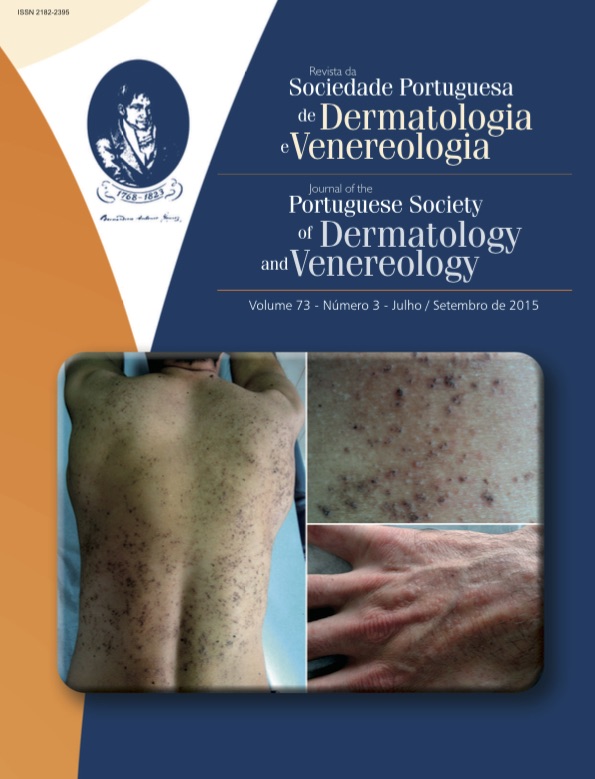PROVAS EPICUTÂNEAS SOB IMUNOSSUPRESSÃO SISTÉMICA – CONTRA-INDICAÇÃO ABSOLUTA?
Resumo
Introdução: As provas epicutâneas (PE) são o exame complementar de diagnóstico indicado para avaliação de suspeita de dermite de contacto alérgica. Idealmente, devem ser realizadas sem que o doente se encontre sob imunossupressores. Existem contudo situações clínicas em que tal não é possível, não havendo informação disponível acerca de como realizar e valorizar os resultados das PE nestes doentes. O objectivo do presente trabalho é rever a literatura no que concerne à realização de PE sob imunossupressão iatrogénica.
Material e Métodos: Revisão da literatura relevante para o tema publicada até Janeiro de 2015 e indexada à Medline.
Resultados: De acordo com o reportado na literatura, foram realizadas PE em 77 doentes sob corticóide sistémico, 78 doentes sob ciclosporina (CyA), 6 sob azatioprina, 10 sob metotrexato (MTX), 4 sob micofenolato de mofetil (MMF), 11 sob fármacos anti-factor de necrose tumoral e 7 sob fármaco anti-IL-12/23. Foram ainda descritos 15 casos de realização de PE sob associação de imunossupressores. Verificaram-se reacções positivas em todos os grupos.
Conclusão: O tratamento concomitante com imunossupressores não deve ser uma contra-indicação para realização de PE, estando descritas reacções positivas em doentes sob prednisolona, azatioprina, CyA, MTX, MMF, infliximab, etanercept, adalimumab e ustecinumab. Os resultados negativos ou duvidosos devem, contudo, ser interpretados de forma cautelosa.
Downloads
Referências
Rosmarin D, Gottlieb AB, Asarch A, Scheinman PL. Patch- testing while on systemic immunosuppressants. Dermatitis. 2009; 20(5):265-70.
Anveden I, Lindberg M, Andersen KE, et al. Oral prednisone suppresses allergic but not irritant patch test
reactions in individuals hypersensitive to nickel. Contact Dermatitis. 2004; 50(2):298-303.
Wentworth AB, Davis MDP. Patch Testing With the Standard Series When Receiving Immunosuppressive Medications. 2014:195-200.
Kim N, Notik S, Gottlieb AB, Scheinman PL. Patch Test Results in Psoriasis Patients on Biologics. 2014; 25(4).
Zollner TM, Igney FH, Asadullah K. Acute and chronic models of allergic contact dermatitis: advantages
and limitations. Ernst Schering Res Found Workshop. 2005:255-75.
Niiyama S, Tamauchi H, Amoh Y, Terashima M, Matsumura Y, Kanoh M, Habu S, Komotori J KK. TH2 immune
response plays a critical role in the development of nickel-induced allergic contact dermatitis. Int Arch Allergy
Immunol. 2010; 153(3):303-14.
Czarnobilska E, Jenner B, Kaszuba-zwoinska J, Kapusta M, Obtu K, Thor P. Contact allergy to nickel: patch test score correlates with IL-5, but not with IFN-gamma nickel-specific secretion by peripheral blood lymphocytes. Ann Agric Env Med. 2009;16(1):37-41.
Masjedi K, Ahlborg N, Gruvberger B, Bruze M, Karlberg a. Contact Dermatitis and Allergy Methylisothiazolinones elicit increased production of both T helper ( Th ) 1- and Th2-like cytokines by peripheral blood mononuclear cells from contact allergic individuals. 2003:1172-82.
Martins LE RV. Cytokine detection for the diagnosis of chromium allergy * Detecção de citocinas no diagnóstico de pacientes alérgicos ao cromo. J Eur Acad Dermatol Venereol. 2013; 88(5):719-25.
Olupona T, Scheinman P. Successful patch testing despite concomitant low-dose prednisone use. Dermatitis. 2007; 19:117-8.
Jackson S, Gilchrist H NLJ. Update on the dermatologic use of systemic glucocorticosteroids. Dermatol Ther. 2007; 20(4):187-205.
Feuerman E LA. A study of the effect of prednisone and an antihistamine on patch test reactions. Br J Dermatol. 1972; 86:68-71.
Wee JS, White JM MJ et al. Patch testing in patients treated with systemic immunosuppressive agents and cytokine inhibitors. Br J Dermatol. 2010; Conference 2:165-9.
Madan V GC. Systemic ciclosporin and tacrolimus in dermatology. Dermatol Ther. 2007; 20:239-50.
Vena G a., Foti C, Piazzola L, Angelini G. Can cyclosporin A help distinguish allergic from irritant patch
test reactions? Contact Dermatitis. 1994; 31:256-7. doi:10.1111/j.1600-0536.1994.tb01998.x.
Higgins EM, McLelland J, Friedmann PS, Matthews JN SS. Oral cyclosporin inhibits the expression of contact hypersensitivity in man. J Dermatol Sci. 1991; 2(2):79-83.
Flori L, Perotti R, Mazzatenta C AL. Cyclosporin A in the treatment of severe allergic contact dermatitis. J Eur Acad Dermatol Venereol. 1993; 2:200-6.
Flori ML AL. Patch tests after cyclosporin A treatment in hyperreactive patients. Contact Dermatitis. 1994;
(5):325.
Patel A, Swerlick R MC. Azathioprine in dermatology: the past, the present, and the future. J Am Acad Dermatol. 2006; 55:369-89.
Pigatto PD, Cesarani a., Barozzi S, Guzzi G. Positive response to nickel and azathioprine treatment. J Eur Acad Dermatology Venereol. 2008; 22:891.
Bangert C CM. Methotrexate in dermatology. Dermatol Ther. 2007; 20:216-28.
Zwerner J FD. Mycophenolate mofetil. Dermatol Ther. 2007; 20:229-38.
Rosmarin D, Bush M, Scheinman PL. Patch testing a patient with allergic contact hand dermatitis who is taking infliximab. J Am Acad Dermatol. 2008; 59:145-7.
Nosbaum A, Rozieres A, Balme B, Goujon C, Nicolas JF, Bérard F. Blocking T helper 1/T helper 17 pathways
has no effect on patch testing. Contact Dermatitis. 2013; 68:58-9.
Johansen JD, Aalto-Korte K, Agner T, Andersen KE, Bircher A, Cannavó et al. ESCD practical guideline on
diagnostic patch testing. Recommendations on best practice. Contact Dermatitis 2015 (in press).
Todos os artigos desta revista são de acesso aberto sob a licença internacional Creative Commons Attribution-NonCommercial 4.0 (CC BY-NC 4.0).








